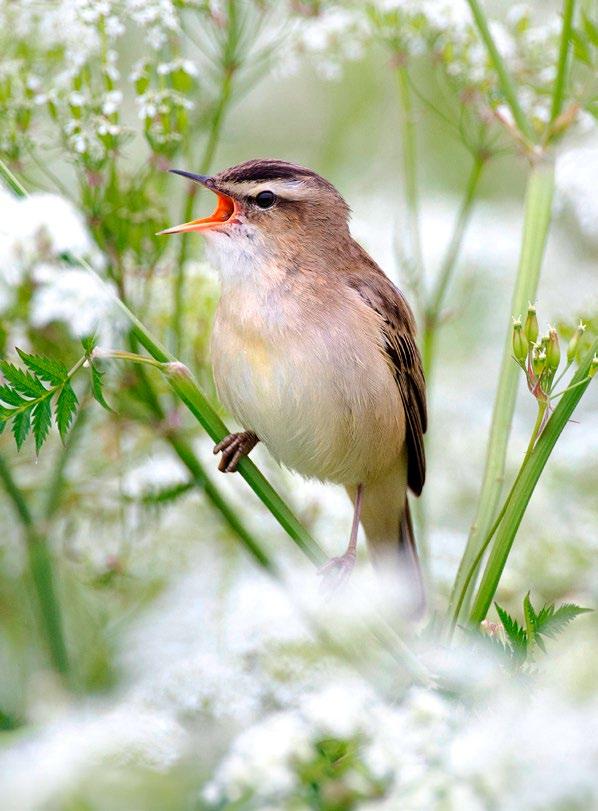
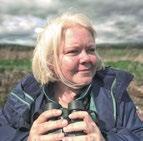



Spring is when nature wakes up. If you’ve experienced the dawn chorus, you’ll know how incredible this season is. As the sun rises, beautiful melodies begin. Our feature (p8) has advice for tuning into the birdsong.
Earlier this year we were delighted to see the results of 25 years of campaigning, with Scottish Government announcing the end of industrial sandeel fishing in Scottish waters. This is a milestone for nature, and a vital step in protecting seabirds. Thank you to the 11,000 people who supported this campaign.
With our Conservation Coalition partners and supporters we continue to advocate for nature at Coul Links. The decision by Highland Council to grant planning permission for a golf course on this protected site was disappointing, but together we urged Ministers to save this special place, and the Scottish Government called in the plans. They will now decide whether the development can go ahead. Find updates by scanning the code below.
Thank you for your support, and your membership, which allows us to deliver all that we do for Scotland’s nature.
And don’t forget to check out Scotland’s results from the Big Garden Birdwatch: rspb.org.uk/birdwatch


Anne McCall Director, RSPB Scotland
Follow Anne on @stranyannie
Many thanks to everyone who has shared their nature photos with us – we love to see them! To get in touch please contact the editor, Molly Martin, at molly.martin@ rspb.org.uk





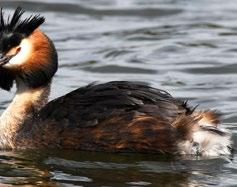

New research has revealed the changing diet of breeding Whitetailed Eagles in Scotland. The 20-year study found the proportion of nests containing lamb remains has declined, with marine prey of seabirds and fish now the species’ most important food source.
In 1998, when the study began, there were only 18 pairs of Whitetailed Eagles, mostly in the Inner Hebrides. By the end of the study in 2017, the population had significantly increased and expanded to at least 122 pairs in locations across Scotland, and 58 of these were sampled that year.
Food remains were collected from White-tailed Eagle nests and territories at the end of each breeding season and then analysed.
In total 11,375 different food items were recorded in 293 samples from nest sites in 92 territories. These showed an incredibly diverse diet that included 70 species of bird, 17 species of mammal, and at least 30 species of fish.
At the start of the study period, between 1998 and 2002, 15 nests were sampled, and lambs accounted for more than 30% of items in five of those nests. A previous study found that lambs tended to be scavenged as carrion, though live ones were also killed on occasion. However, as the population expanded, pairs establishing in new territories tended to feed on fewer lambs; by 2017 lambs accounted for 30% or more of items at just five of 58 nests sampled. The most common species found was Fulmar, at 30% of items per nest. This demonstrates the birds’ foraging and scavenging feeding techniques and their ability to adapt what they eat based on geographical location. The study was published as a peer-reviewed paper in the Scottish Ornithologists’ Club journal, Scottish Birds, and should help inform an evidence-based approach to NatureScot’s Management Scheme for White-tailed Eagles, as well as providing reassurance to farmers and crofters with livestock concerns.
The efforts of the Tiree community are proving vital in helping Great Yellow Bumblebees on the island. In 2022 a bank of sand behind a new petrol station at Crossapol, adjacent to our Reef nature reserve, was planted with native wildflower seed thanks to assistance from Tiree Community Development Trust and two volunteers. These rare bumblebees favour warm, sunny weather, and while their 2023 season in Tiree began promisingly, the lack of rain and continued sunshine dried out the machair soils, so many of the wildflowers withered away. Great Yellow Bumblebee queens, which emerge in mid-June – later than others – need a rich supply of nectar after an eight-month hibernation, so the loss of these flowers was worrying.
However, the wildflowers on the bank of sand survived and were a lifeline for the bees; up to six queens at a time visited the flowers, along with other species. The return of rain in late June allowed the machair flowers to recover, and in the meantime the bees continued to use the planted-up area. Tiree’s Great Yellow Bumblebees are essential to helping the population on the Isle of Coll, where they have become very scarce. It’s thought the bees can make the 3.5km sea-crossing flight between the two islands!
More areas are being planted up as part of Species on the Edge, supported by the National Lottery Heritage Fund. We will be monitoring the bee numbers again this summer.
Make your space into a haven for bees and other wildlife. Find everything you need to know by scanning the code.

The wonderful new lookout hide at Insh Marshes, near Kingussie, opened in February. The new hide replaces the previous structure, which was burned down in 2022.
Incorporating additional safety measures, the new hide offers sweeping views of the nature reserve, plus chances of spotting species such as Whooper Swans, Hen Harriers and, if you’re lucky, White-tailed Eagles.
Some areas are grazed by sheep, cattle and ponies – see if you can spot any of them from this fantastic new structure.


Towards the end of 2023, we completed a successful second release of Beavers at our Loch Lomond nature reserve. This time a male and female were released, again under the careful supervision of experts from the Beaver Trust. The Beavers have settled in well, with remote cameras capturing clips of their antics. This was possible as the Beavers released here in early 2023 set up territory outside our nature reserve, in the huge quantity of suitable habitat elsewhere in the National Nature Reserve.
Beavers are also back at another of our nature reserves. Thanks to a project led by the Cairngorms National Park Authority, in late December 2023 Beavers were returned to the Upper Spey after an absence of more than 400 years. Our Insh Marshes nature reserve is one of the three initial release sites, and earlier this year Beavers were released there.
The team at RSPB Scotland Loch Leven nature reserve has been working hard to make it as accessible and inclusive as possible, with a vision of being one of the most accessible nature reserves in Scotland.
So far, this has included transforming a cramped, dark underpass accessed only via steep steps into a wide, light under-road crossing point with a gently sloping access ramp, new facilities at the visitor centre, including a Changing Places Toilet, and inclusivity

This is a major milestone in the return of this species in Scotland and we’ve been delighted to support it. While it’s unlikely that visitors to the nature reserves will see the Beavers, we are excited about the benefits they provide to the habitat and other wildlife that should be visible over time.
training for all the staff and volunteers, with further work still to come.
And all this effort has now been recognised by the Scottish Thistle Awards. The awards, run by VisitScotland, celebrate the very best of Scottish tourism, hospitality and events, and we’re delighted that Loch Leven won the award for Inclusive Tourism in the Central and East Region. Congratulations to all the team!
Plan your visit: rspb.org.uk/lochleven
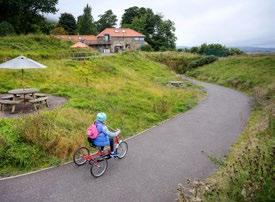


Deer management is a vital part of Cairngorms Connect’s 200year vision for landscape restoration. At natural levels deer are a crucial part of a healthy ecosystem, by lightly grazing, dispersing seeds and as a food source. However, numbers currently far exceed this level, which has had a detrimental impact on the young native tree growth needed for natural forest generation.
The partnership employs 15 deer stalkers to control deer numbers year-round across a 600km2 area. By filling the gap of natural predators, the deer stalkers reduce the number of deer, and also encourage them to move on, so they don’t remain in one place intensively eating the young trees.
The resulting wild venison is available at several local restaurants and shops, including RSPB Scotland’s Loch Garten Nature Centre at Abernethy. The Endangered Landscapes and Seascapes Programme-supported partnership is working with communities to promote its sustainability as a low-carbon option and the benefits as a healthier, alternative red meat.

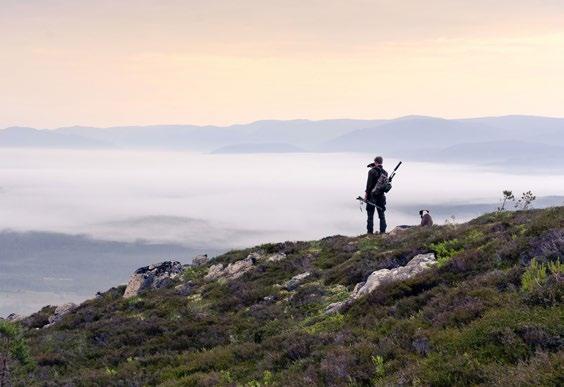
Young people aged between five and 18 have raised an incredible £9,193 for RSPB Scotland. They are all members of Destination Judo, a group of 30 clubs across East Central Scotland.
Destination Judo signed up to the International Judo Federation’s Climate Challenge, which challenged judoka (people who do judo) across the world to do what they could to support and protect the environment. The children were inspired to help Puffins after seeing an RSPB social media post featuring the birds, and watching Sir David Attenborough talk about them on the BBC series Wild Isles
They did a sponsored dash in their judo classes, which they called Puffin’ for Puffins, taking as many judo jackets from one side of the room to the other in one minute for the under-eights, and in 90 seconds for those over eight. They also produced Puffin artwork to promote their fundraising drive. A huge thank you for this amazing effort and support!


The World Economic Forum estimates that 50% of global GDP is reliant on nature, but only 3% of companies measure their impact on it.
That is one of the reasons RSPB Scotland is delighted to partner with ERM Foundation, a consultancy firm that focuses on sustainability. ERM not only explores and restores its own impact on nature, but also works with clients to help them understand, measure and manage risks and opportunities arising from their dependencies and impacts on nature. For so long, conservation work has been about damage reduction, but corporate foundations like ERM Foundation help businesses understand they have a role to play in the protection of nature. Via its corporate foundation, it has also made direct contributions to wildlife and nature in Scotland. As part of its commitment to helping both nature and climate, the support has focused on protecting woodlands – at RSPB Scotland
Abernethy nature reserve in the Cairngorms and RSPB Scotland Glencripesdale nature reserve on the Morvern peninsula.
Kenneth Reid, from the Onshore Renewables Team, says: “ERM Foundation provides fundraising, professional support and staff volunteers to organisations that share our commitment to a more sustainable, more equitable world, full of biodiversity. We are delighted to support RSPB Scotland’s work regenerating native forests for the benefit of wildlife and the local communities.”
At Abernethy, ERM Foundation supported the role of a Seasonal Forest Ranger, who greets visitors and provides information on the ancient Caledonian Pine woods. They also encourage respect for the forest and responsible behaviour around barbecues, campfires and rubbish. In the summer the biggest threat is fire; preventing these and protecting the habitat is a key objective.
At Morvern, its support has allowed us to repair access to our rainforest nature reserve at Glencripesdale, enabling us to
‘Corporate foundations like ERM Foundation have a role to play in the protection of nature’
easily reach and remove Rhododendron and Sitka Spruce regeneration, and repair and restore deer fences to protect the woodlands from over-grazing. For every year that Rhododendron is left to grow, the damage is threefold, so good access is vital. ERM Foundation has also contributed to the recruitment of a Morvern Tree Nursery Manager, to help us create a community tree nursery, collect local provenance seeds and manage the propagation of native tree saplings. These will be used in future rainforest creation and planting schemes across the Morvern peninsula.



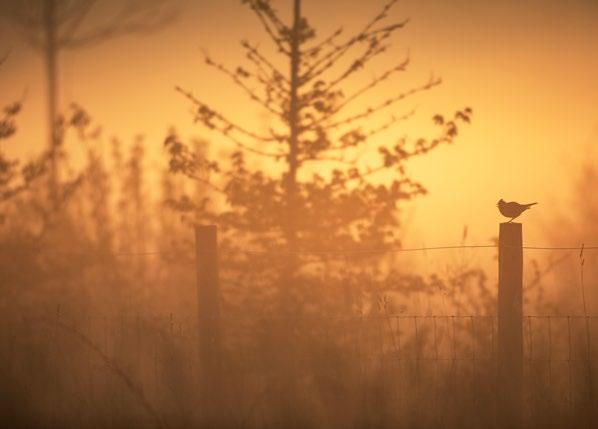
Get up early to listen to the birdsong ringing out on Scotland’s spring mornings and celebrate International Dawn Chorus Day with us
Spring sunrise is when birdsong is at its busiest, loudest and most impressive.
International Dawn Chorus Day takes place on the first Sunday of May, which in 2024 is 5 May, celebrating this wonderful annual musical outburst from nature. Learning to identify birds by their songs can be a challenge at first, but once you get your ear tuned in you will start to pick up how frequently you hear birds singing, the variety of sounds and where they might be hiding.
Many birds sing throughout the year, but between April and June is when this reaches a crescendo, as birds reassert or gain territories and try to attract a mate for the breeding season ahead. The main event happens at dawn, although many will sing throughout the day with another upsurge at dusk.
When trying to learn birdsong, the earlier you start in spring the better, as only resident birds are here then, so you can familiarise yourself with their calls before summer visitors start to arrive. Birds such as the Robin and Song Thrush are some of the earliest to start singing, while the song of the Great Tit really signals that spring is on its way. Once birds such as the Chiffchaff, Willow Warbler and Sedge Warbler arrive in Scotland there are a lot more songs in the mix!
The key thing for making the most of listening to birdsong is to get away from traffic noise, so move as far away from roads as you can. Try a park or woodland, or along old railway lines that have been turned into cycle paths. Take binoculars with you so you can try to see the birds as they sing, rather than identifying by ear alone.
There are also apps you can download on your phone which help identify which birds are singing. Keep in mind that more birds sing in the dawn chorus when the weather is better, so wait for a fine morning.
As the breeding season progresses into summer, the springtime prevalence of birdsong tapers off. Birds don’t want to draw attention to their location if they are nesting. However, birdsong may pick up again at intervals by birds that have multiple broods in a year, such as Blue Tits. You might hear them as they need to once again defend territories and resources to nest, lay eggs and raise their chicks.
As well as their beautiful songs, birds can also be identified by their other calls, such as their alarm calls when threatened by a predator, and the communal noises they make to one another, such as the honks between geese flying together in skeins (flying groups of wildfowl). Rise early this spring and experience it for yourself.

These birds have a varied, melodious song, which is strong, fast and vigorous, falling in pitch while increasing in speed. It pauses between verses, with some soft, others squeaky and some loud, with no set pattern.

This song is a sign that spring is really kicking in. It’s very distinctive, like a variation on ‘tea-cher-tea-cher’ with one high note and one low note, and has been likened to a squeaky bicycle wheel.
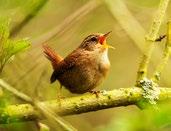
These small birds have one of the loudest songs, a powerful cascade of notes ending with a loud trill that sounds a bit like a rattle. The song lasts between five and seven seconds, sung several times a minute.

Prolific singers with a beautiful, carefree, mellow song that has a slow tempo and a smooth, clear warble that tails off towards the end. They can often be seen perching on top of buildings to sing out their song.

A short, fast and dry-sounding song consisting of a descending series of trills that get faster and end in a flourish. This simple, bright and loud song has a two- or three-note rattle.

In some parts of the Scottish countryside this song is one of the most distinctive. A long, bubbly warble, with soft trills and no set rhythm. They tend to sing in flight but also from perches or on the ground.

Their powerful, flute-sounding song begins in early spring. They sing in short phrases repeated again and again, with pauses in between, similar to a Blackbird. Likely to be on a high perch for their performance.

A descending whistle of ‘see see see-chu -chu -chu’, ending in a short trill. This high-pitched rhythmic song can be heard again in summer, once the first chicks have fledged and the parents are breeding again.
Looking for somewhere to hear the dawn chorus? Find out about International Dawn Chorus Day events at RSPB Scotland nature reserves on page 12

Oronsay, to the south of Colonsay in the Inner Hebrides, is an incredible place – the whole of the small tidal island is a nature reserve, farmed by RSPB Scotland with agreement from the landowner, Oronsay Estate.
The journey here is longer than to most nature reserves, but the wildlife and surroundings make it well worth it! Once on Colonsay there is a small car park at the southern end where you can set off on foot across a tidal sandy strand to Oronsay. It can only be accessed by visitors during low tide, so check the tide times before you go. The walk across takes about half an hour. There are often track marks in the sand to follow, and the old pilgrimage route to a now-ruined priory is shown on the OS map.
Once across, a track heads uphill for about a mile to the priory and farm buildings. From here, you can see most of the island. It’s a great place to stop and take it all in. A lot of Oronsay is low lying and made up of enclosed fields, machair, sand dunes and beaches. But Beinn Oronsay, the tallest hill at 92 metres, will catch your eye.
In spring and summer you can see Goldfinches, Twites and Skylarks flitting about. Snipe, Lapwings, Meadow Pipits, Linnets, Eiders and Redshanks are some of the birds that will be hidden among the grasslands and shorelines, taking care of their nests. Rare solitary mining Northern Colletes bees burrow in the sand dunes.
Please keep in mind that the whole island is a working farm,
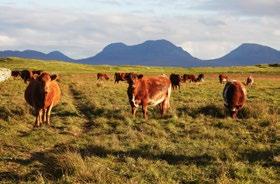
with Luing cattle and Scottish Blackface and Hebridean sheep, which are not always obvious. Abide by the Scottish Outdoor Access Code, follow the signs and close all gates. Please keep to the tracks and keep dogs on a short lead, especially during spring and summer when ground-nesting birds are breeding, and lambing and calving are taking place.
The farm animals are a vital part of how the nature reserve supports wildlife, especially very rare Corncrakes and Choughs. In spring and summer, the fields around the farm buildings are closed off to provide nesting habitat for Corncrakes. While you’re unlikely to see these shy birds, you might hear their distinctive ‘crex crex’, the sound of summer here.
Choughs can be seen throughout the year, thanks to food provision from the insects in the cattle dung and the Kelp Fly larvae along the shore. In autumn and winter the noisy calls of Barnacle Geese can be heard. From the buildings, follow the track along a walled avenue into a field, then out onto dune grassland. There is beautiful beach with white sand and blue water.
The sea is always by your side as you explore. Grey Seals are often seen in the water and hauled out on the beach, and there are stunning views over to Islay and Jura to enjoy.




Spring/summer highlights
The machair bursts into colourful flower, filled with buzzing bumblebees, while Marsh Fritillaries fly about and a variety of orchids grow along the track verges. As the end of summer draws in, big groups of finches arrive to make the most of all the seedheads on offer.
rspb.org.uk/days-out/ reserves/oronsay

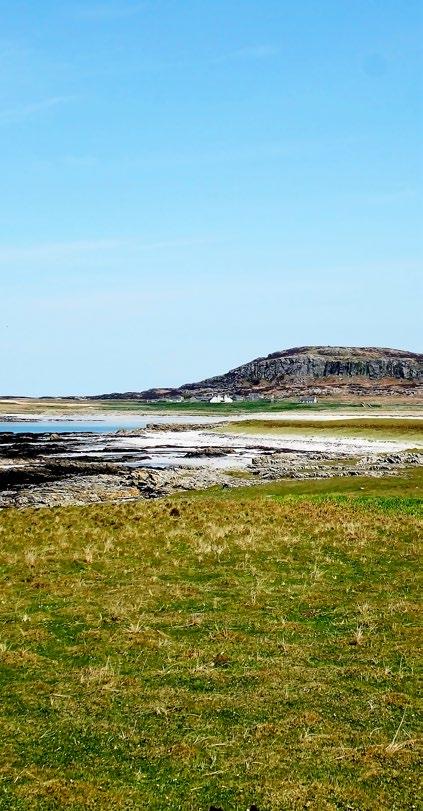
people

What’s your favourite thing about Oronsay?
The remote location paired with beautiful beaches makes it a very special place. Only six people live here full-time, so it’s very peaceful.
What’s the most interesting or unusual part of your job?
Oronsay is an unusual place to be a warden as so much of my job involves hands-on work with the sheep and cattle here. I love the mix between farm work and a more traditional warden role.
What’s your favourite species to see here?
I always feel very lucky to see Corncrakes as they’re usually difficult to spot. You just have to be in the right place at the right time. We often see them from the tractor.
Tell us something about the nature reserve that we might not know
Oronsay is an island with a lot of history. There are signs of previous inhabitants, including an Iron Age hill fort, and Mesolithic shell middens are all over the island.
For the latest RSPB Scotland events, including up-to-date information and new listings, please head to our website events.rspb.org.uk/scotland

Dawn Chorus Walk
RSPB Scotland Loch Leven
4 May and 5 May, 6am–7.30am
Wake up to a cacophony of sound. Perfect for the wildlife enthusiast wanting to discover more about birdsong, learn about birdwatching, identification and the wildlife that lives here on this leisurely walk. Binoculars included.
Booking: events.rspb.org.uk/ lochleven
Price: members £13, non-members £16

Dawn Chorus
Guided Walk
RSPB Scotland Lochwinnoch
5 May, 5am–7am
Soak up the sound of birdsong as it builds to a crescendo. The walk will follow trails and footpaths for 2.5 miles. Wear sturdy footwear and weatherappropriate clothing. We’ll end with a hot drink and pastry.
Booking: events.rspb.org.uk/ lochwinnoch
Price: members £13, non-members £16
With longer days ahead it’s a great time to explore our nature reserves. The RSPB is offering free entry for people aged 16–24 to its nature reserves where there is a charge – in Scotland this means free entry to our Loch Garten nature reserve!
We want to make our natural world as accessible as possible. We know that young people are less likely to visit our nature reserves, with cost being one of the main barriers, so we hope this helps more young people to discover these incredible places for nature. Find out more at rspb.org.uk/free-youth-access
information is correct at the time of printing – for
RSPB Scotland Headquarters 2 Lochside View, Edinburgh Park, Edinburgh EH12 9DH 0131 317 4100
rspb.scotland@rspb.org.uk
North Scotland offices Etive House, Beechwood Park, Inverness IV2 3BW 01463 715000 nsro@rspb.org.uk
easyHub Aberdeen, Royfold House, Hill of Rubislaw, Aberdeen AB15 6GZ 01224 624824 nsro@rspb.org.uk
South Scotland office 10 Park Quadrant, Glasgow G3 6BS 0141 331 0993
glasgow@rspb.org.uk

Dawn Chorus Walk
RSPB Scotland Loch Lomond
11 May, 4.30am–7am (STC)
Join us to listen for the first calls of the day from a variety of birds. This walk will take you across different areas of the nature reserve and finish with a hot drink and pastry. Dress appropriately for the outdoors
Booking: events.rspb.org.uk/ lochlomond
Price: members £13, nonmembers £16; child member £7, child non-member £8.25

RSPB Scotland has a network of enthusiastic local groups. Find one near you: rspb.org.uk/localgroups

RSPB Scotland Loch Lomond
11 May, 11am–1pm
Join us for an unforgettable guided walk through Bluebellcarpeted woodlands, where vibrant blues merge with the lush greenery of spring. Listen to the rustle of new leaves, the harmony of birdsong and the soft rush of nearby burns.
Booking: events.rspb.org.uk/ lochlomond
Price: members £8.50, non-members £10; child member £5, child non-member £5.50
Find us on social media: RSPBScotland @rspb.scotland @RSPBScotland
Subscribe to our podcast: bit.ly/rspb-scotland-podcast and our YouTube playlist: bit.ly/rspb-scotland-playlist